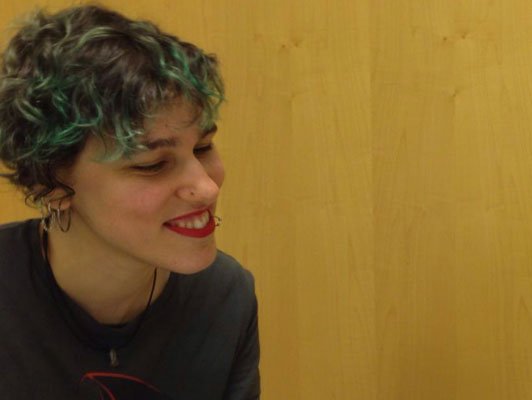MangaForever intervista Maria Llovet
Pubblicato il 28 Dicembre 2016 alle 15:00

L’autrice spagnola si racconta ai nostri microfoni.
Con grande spirito di iniziativa Edizioni BD ha portato in Italia Heartbeat graphic novel che unisce una spiccata estetica orientale con una sceneggiatura che si rifà ai thriller più introspettivi.
Leggi la nostra recensione qui.
Sempre grazie ad Edizioni BD abbiamo avuto modo di chiacchierare con la giovane autrice di Heartbeat – la spagnola Maria Llovet che ci ha raccontato le influenze e la genesi del graphic novel, della sua esperienza italiana in quel del Lucca Comics and Games dello scorso anno e della influenza di alcuni disegnatori italiani.
Benvenuta su Mangaforever Maria! Puoi presentarti ai nostri lettori che non ti conoscono e non hanno familiarità con i tuoi lavori?
Ciao! Come state? Grazie per avermi invitato!
Mi chiamo Maria Llovet, sono una fumettista ed illustratrice spagnola.
Heartbeat è il tuo primo lavoro pubblicato qui in Italia, qual è l’idea alla sua base? Quali sono state le maggiori influenze?
L’idea alla base di Heartbeat mi è venuto dopo aver guardato un film giappone intitolato Kokuhaku (Confessioni). In questo film c’era una sottotrame dove i protagonisti discutevano di alcune ragazze appassionate di omicidi di massa.
Mi è sembrata una idea interessante; come è possibile che qualcuno decida di sbarazzarsi del proprio codice morale e dei propri valori per idolatrare qualcuno che non ha nessun codice morale. Questo è stato il punto di partenza per la storia che volevo raccontare.
Il nucleo centrale del libro è la solitudine di Eva. Pensi che Eva sia un archetipo di tanti ragazzi e ragazze di oggi?
Spero proprio di no! All’inizio della storia, Eva è una studentessa vittima di bullismo, e sta attraverso un momento davvero duro della sua vita. Proviamo empatia per lei. Ma questo non la rende innocente di per sé.
Ad un certo punto, Eva inizia a cambiare il suo comportamento e diventare meschina. Il suo percorso durante la storia è negativo anche se ha parecchie opportunità di cambiarlo e ripensarci.
Spero davvero che i ragazzi, quelli reali, non siano trascinati in questa direzione.
Nella seconda parte del libro, quando Eva e Donatien stringono il loro legame “speciale”, iniziamo a comprendere che anche i personaggi “secondari” sono pieni di segreti il che rende la solitudine di Eva qualcos’altro, qualcosa di più grande che abbraccia la vita di tutti i giorni. Siamo davvero bloccati in un mondo senza più innocenza? E la morbosa relazione con Donatien è davvero l’unica via di fuga per Eva?
Il vero punto focale di Heartbeat consiste nel fato che ogni personaggio sceglie di fare qualcosa di sbagliato e cattivo. Possono essere innocenti fino ad un certo punto (come Eva all’inizio) ma alla fine scelgono di non esserlo, si lasciano alle spalle la loro innocenza completamente consci delle loro scelta.
Tutti eccetto Donatien, che è più che altro un catalizzatore per tutti gli altri, hanno diverse opzioni e momenti in cui possono cambiare il loro percorso e cambiare direzione verso un fine diverso. Ma tutti scelgono di essere cattivi. Questo è il tema portante del libro, la possibilità di scegliere.
Il finale sembra un finale aperto, hai in programma un Heartbeat 2?
No, per me la storia è chiusa definitivamente.
Anche se pare essere un finale aperto, se rifletti un attimo su quello che accade in quel mondo ed alle parole di Eva che sono espresse al passato, è abbastanza ovvia la piega che prenderanno gli avvenimenti.
Parliamo un pò del tuo stile che è molto influenzato dai manga specialmente guardando all’estetica dei personaggi ma quello che mi ha colpito maggiormente è che hai preferito costruire le tavole in maniera orizzontale, come mai?
Sì perché la mia maggior influenza è il cinema. Utilizzo anche una griglia da 9 o 12 riquadri, 3×3 o 4×3 e la loro combinazione. Mi concentro maggiormente nelle composizioni panoramiche, permettendomi di creare un mood specifico. Penso che ormai parte del mio linguaggio, non saprei fare altrimenti.
Ritrovo nel tuo stile anche un mix di Emma Rios e Fiona Staples, pensi che Heartbeat possa attirare l’attenzione l’attenzione sia del pubblico maschile che femminile?
Non saprei, penso che i miei lavori incontrino maggiormente i gusti del pubblico femminile ma è anche vero che ho tanti lettori. Penso dipenda dal libro. Con Heartbeat ma ancora di più con Insecto (il mio graphic novel successivo ad Heartbeat) ho avuto un incremento di lettori rispetto ai miei due lavori precedenti.
Un altro fattore può essere anche il mio stile, lo sto cambiando parecchio ultimamente, e quello che sto facendo adesso è molto differente dallo stesso Heartbeat.
Hai scritto e disegnato Heartbeat, quanto la scrittrice influenza la disegnatrice e viceversa?
Ah questo è un argomento davvero interessante e concerne la “narrativa”. Il punto esatto in cui lo scrittore si fonde con il disegnatore è il momento il cui si uniscono story board e ritmo narrativo e si decide il passo della storia. E’ la mia parte preferita ma è diverso quando lo faccio per i miei lavori da quando lavoro su commissione.
Quando è una mia storia, scritto pensando “visivamente” dall’inizio. Questo non significa che so esattamente dove andrò a finire, ma immagino sempre la scena in movimento e ci sono anche volte in cui scrivo descrivendo quello che dopo diverrà lo storyboard.
Invece se lavoro con un altro scrittore questo processo diventa quasi una “traduzione”. Devo trasformare la sceneggiatura nel mio linguaggio visivo ed è davvero complicato e stancante. L’importante comunque è adattare il tutto in qualcosa che per te funzioni.
Più in generale se non attui questo processo si crea un zona grigia fra i due creatori di cui non si occupa nessuno. Molti scrittori non pensano “visivamente” ed è compito del disegnatore scovarla e contribuire con la sua visione narrativa alla pagina finale.
Stai lavorando a qualcosa di nuovo attualmente?
Si! Sono impegnati in diversi lavori che mi hanno commissionato dagli USA e dalla Francia, uno di questo è un fumetto chiamato “There’s Nothing There” scritto da Patrick Kindlon ed è il primo lavoro per il USA e ne sono davvero entusiasta! Uscirà in primavera.
Sto anche preparando il mio prossimo graphic novel “LOUD” una storia ambientata in un night club durante l’arco di una nottata e praticamente senza dialoghi in quanto il volume della musica non permette ai personaggi di sentirsi.
Oltre scrivere e disegnare quali sono i tuoi hobby ed i tuoi interessi?
Amo il cinema, guardo un sacco di film appena ne ho la possibilità, è la mia principale fonte di ispirazione e di apprendimento.
Mi piace leggere anche se purtroppo ho sempre meno tempo per farlo.
Mi piace anche l’industria della moda, specialmente la fashion photography ed anche le designer’s collection anche queste sono fonti di ispirazione.
Sei stata ospite di Lucca Comics and Games 2016, cosa ricordi di quella esperienza e dei fans italiani? Conosci qualcuno dei nostri fumetti? Ti piacciono?
E’ stato assolutamente fantastico! Ho passato dei giorni veramente spledidi ed i ragazzi di Edizioni BD sono stati fantastici, il pubblico caldissimo e la città affascinante. Spero di tornare presto!
Ovviamente sì! Una delle mie principali influenze ed artista preferito è Guido Crepax. Mi piacciono anche Manara, Hugo Pratt e Toppi.
Anche per questo per me è piacere essere stata pubblicata in Italia!
Muchas gracias, Maria.
Grazie per il tuo tempo e buona fortuna con i tuoi prossimi progetti speriamo di vedere altri tuoi libri presto sugli scaffali delle librerie italiane.
Grazie!! Grazie mille!! :)
Se volete potete acquistare il volume qui:
Nella prossima pagina l’intervista in lingua inglese!
–
Welcome to Mangaforever Maria! Can you introduce yourself to our readers who are not familiar with you and your works…
Hi! How are you? Thank you for having me!
Well, my name is Maria Llovet, and I’m a comic author and illustrator from Spain.
Heartbeat is your first work published here in Italy, what’s the idea behind it? What were the main influences?
The idea for Heartbeat came to me after watching a japanese movie called Kokuhaku (Confessions). In this movie there’s a subplot where the characters talk about a couple of girls who were fans of a mass murderer.
This idea appeared very interesting to me; how could someone decide to get rid of their moral codes and values to idolize someone who does not have any moral code. That was the starting point for the story I wanted to tell.
The core of this book is Eva’s loliness. Do you think that Eva is an archetype for a lot of young boys and girls nowdays?
I really hope not!! At the beginning of the story, Eva is a bullied student, and has a really hard time in her life. We could empathise with her. But that doesn’t make her innocent per se.
At a certain point, Eva starts to change her behaviour and becomes mean. Her journey during the story is a negative one, even though she has many opportunities to change and reconsider.
So I really hope the real young people are not really driven into that direction.
In the second half of the book, when Eva and Donatien make their “special” bond, we start to understand that also the “secondary” characters are full of secrets which make Eva’s loliness something else, something bigger that embraces everyday life. Are we really stuck in a world without innocence? Is the morbid relationship with Donatien the only escape way for Eva?
The real point about Heartbeat is that every character on it is choosing to do something they know is wrong and mean. They may be innocent at some point (like Eva at the beginning) but they all choose not to be, they leave their innocence behind completely aware of that choice.
All except Donatien, who is more of a catalyst for the rest of them, have different options and different moments where all their paths could change direction and propel a different ending. But they all choose to be bad. That’s the real theme of this work, the possibility of choosing.
The ending seems a little bit an open one, do you plan an Heartbeat 2?
No, for me the story is completely closed.
Even if it looks like it’s an open ending, if you think a bit about what is going to happen in the next few hours in this world, plus the past tense in the off voice of Eva, it’s pretty obvious the direction that the events are going to take.
Let’s talk about your style which is very “manga influenced” especially looking to the aesthtetic of the characters but the thing that striked me the most is that you’ve preferred a horizontal construction of the panels why so?
Yes, that’s because the main influence in my work is cinema. I also use a 9 or 12 pannel grid, 3×3, or 4×3 and their combinations. But mainly I’m interested in the panoramic compositions, they are my favourite and allow me to create a specific mood. I think it’s part of my own language already, I couldn’t do it otherwise.
I also found a mix of Emma Rios and Fiona Staples in your style, do you think that Heartbreak may catch the eye of both a female and male audience?
I really don’t know, I think my works tend to appeal more to female audience, but it’s true I have male readers too. I guess it may depend on every work. On Heartbeat but specifically more on Insecto (my last graphic novel after Heartbeat) I’ve had more male readers than in my two previous works.
Or maybe it has something to do with the style, I’m mutating quite a lot lately, and what I do now is very different from Heartbeat, too.
You wrote and drawn Heartbeat, how much the writer influences the penciller and vice versa?
Ah, that’s a very interesting subject, it has to do with the “narrative”. The exact point where the writer merges with the penciller. It’s in the moment of making the story board and decide the narrative pace and rhythm where all this mixes together. Is my favourite part of the process, but it’s very different when I do it on my own works or when I do it on commissioned work.
When the story is mine, I write thinking “visually” from the beginning. That doesn’t mean I know exactly how it’s going to be, but I always imagine the scene in movement and there are many times that I write describing what later is going to become the storyboard.
On the contrary, when I work with another writer, this process becomes something like a “translation”. I have to transform their script into my own visual language and is a very complicated and tiring process. But it’s very important to adapt it into something you feel works well with you.
In general, if you don’t do this process of translation there’s this grey space in between the two creators that nobody is taking care of. Many writers don’t think visually, and it is part of the work of the artist to reach to contribute with their visual narrative to the final page.
Are you working on something new right now?
Yes! I’m working on several commissioned works for the US and France, one of them is a comicbook called There’s Nothing There written by Patrick Kindlon, which is my first work for the US, and I’m very excited about! It will be out this spring.
I’m also preparing my next graphic novel “LOUD”, a story set up in a night club that happens in only one night and nearly without dialogs, as the sound level of the music does not allow the characters to hear each other.
Besides writing and drawing what are your hobbies and interests?
I love cinema, I watch many kinds of movies as often as I can, it is my main source of inspiration and also of learning.
I love to read, even if I have less and less time for it, sadly.
And also I love following fashion industry, specially fashion photography but also designer’s collections, etc. It helps me a lot with inspiration too.
You were one the Lucca Comics and Games 2016 guest, how you recall your Lucca and the italian fans? Were you familiar with some italian comics? Do you like them?
It was absolutely wonderful! I had a really great time, the people at Edizioni BD were amazing, the public lovely, and the city so charming, I really hope I can come back!
And yes of course! On of my main influences and favourite artists of all time is Guido Crepax. And I also love the works of Manara, Hugo Pratt or Toppi.
So it is a real pleasure for me to be published in Italia!
Muchas gracias, Maria.
Thank you for your time and good luck for your next projects we hope to see more of your books on italian shelves.
Thank you!! Grazie mille!! :)



